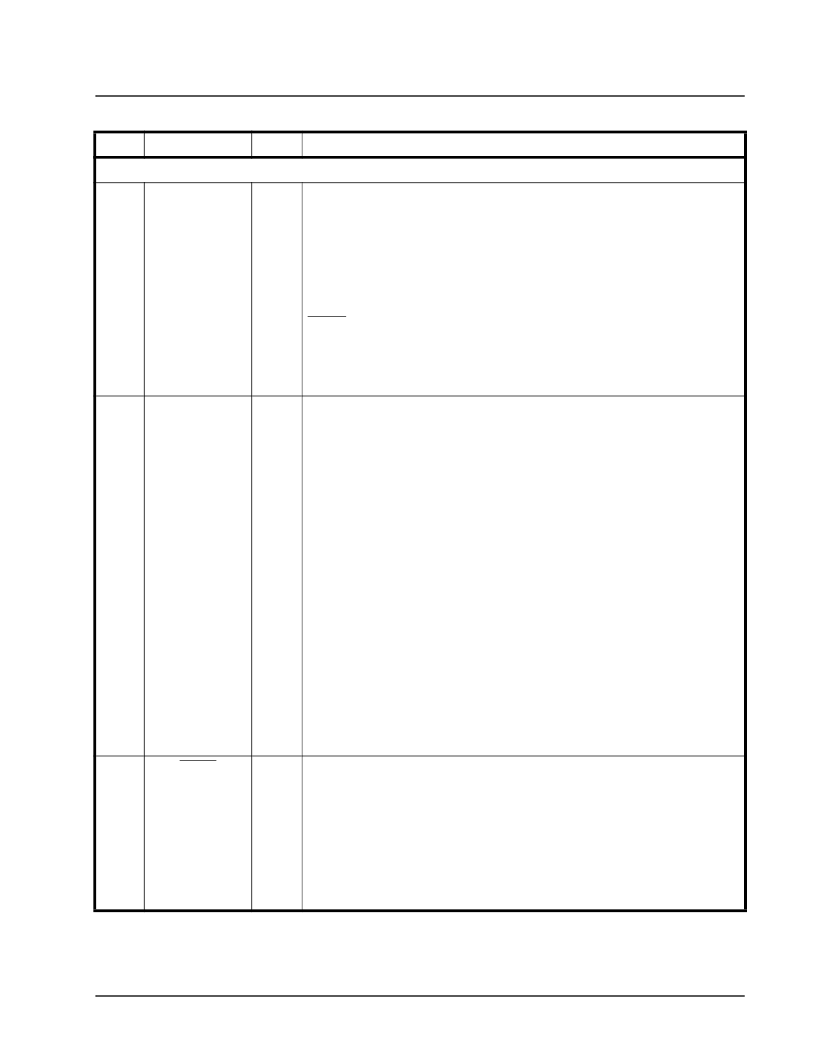- 您現(xiàn)在的位置:買賣IC網(wǎng) > PDF目錄376461 > XRT72L73 (Exar Corporation) Ultraframer DS3/E3/DS2/E2/DS1/E1/DS0 PDF資料下載
參數(shù)資料
| 型號: | XRT72L73 |
| 廠商: | Exar Corporation |
| 元件分類: | 通信及網(wǎng)絡 |
| 英文描述: | Ultraframer DS3/E3/DS2/E2/DS1/E1/DS0 |
| 中文描述: | Ultraframer DS3/E3/DS2/E2/DS1/E1/DS0 |
| 文件頁數(shù): | 29/105頁 |
| 文件大小: | 1307K |
| 代理商: | XRT72L73 |
第1頁第2頁第3頁第4頁第5頁第6頁第7頁第8頁第9頁第10頁第11頁第12頁第13頁第14頁第15頁第16頁第17頁第18頁第19頁第20頁第21頁第22頁第23頁第24頁第25頁第26頁第27頁第28頁當前第29頁第30頁第31頁第32頁第33頁第34頁第35頁第36頁第37頁第38頁第39頁第40頁第41頁第42頁第43頁第44頁第45頁第46頁第47頁第48頁第49頁第50頁第51頁第52頁第53頁第54頁第55頁第56頁第57頁第58頁第59頁第60頁第61頁第62頁第63頁第64頁第65頁第66頁第67頁第68頁第69頁第70頁第71頁第72頁第73頁第74頁第75頁第76頁第77頁第78頁第79頁第80頁第81頁第82頁第83頁第84頁第85頁第86頁第87頁第88頁第89頁第90頁第91頁第92頁第93頁第94頁第95頁第96頁第97頁第98頁第99頁第100頁第101頁第102頁第103頁第104頁第105頁

á
XRT72L73
THREE CHANNEL, DS3 ATM UNI/CLEAR-CHANNEL FRAMER
PRELIMINARY
REV. P1.0.1
29
Tx UTOPIA Interface
AC11
AF11
AE11
AD11
TxUAddr0
TxUAddr1
TxUAddr2
TxUAddr3
TxUAddr4
I
Transmit UTOPIA Address Bus Input:
These pins comprise the Transmit UTOPIA Address Bus input pins. The Transmit
UTOPIA Address Bus is only in use when the UNI is operating in the M-PHY
mode. When the ATM Layer processor wishes to write data to a particular UNI
device, it will provide the address of the “intended UNI” on the Transmit UTOPIA
Address Bus. The contents of the Transmit UTOPIA Address Bus input pins are
sampled on the rising edge of TxUClk. The DS3 UNI will compare the data on the
Transmit UTOPIA Address Bus with the pre-programmed contents of the TxUT
Address Register (Address = 70h). If these two values are identical and the
TxUEN pin is asserted, then the TxUClav pin will be driven to the appropriate state
(based upon the TxFIFO fill level) for the Cell Level handshake mode of operation.
N
OTE
:
The user should tie this input pin to “GND” whenever the XRT72L73 has
been configured to operate in either the “Clear-Channel-Framer” Mode or in the
“Single-PHY” Mode.
Transmit UTOPIA Interface—Cell Available Output Pin:
This output pin supports data flow control between the ATM Layer processor and
the Transmit UTOPIA Interface block. The exact functionality of this pin depends
upon whether the UNI is operating in the “Octet Level” or “Cell Level” handshaking
mode.
Octet Level Handshaking:
When the Transmit UTOPIA Interface block is operat-
ing in the octet-level handshaking mode, this signal is negated (toggles “Low”)
when the TxFIFO is not capable of handling four more write operations; by the
ATM Layer processor to the Transmit UTOPIA Interface block. This signal will be
asserted when the TxFIFO is capable of receiving four or more write operations of
ATM cell data.
Cell Level Handshaking:
When the Transmit UTOPIA Interface block is operating
the cell-level handshaking mode, this signal is asserted (toggles “High”) when the
TxFIFO is capable of receiving at least one more full cell of data from the ATM
Layer processor. This signal is negated, if the TxFIFO is not capable of receiving
one more full cell of data from the ATM Layer processor.
Multi-PHY Operation:
When the UNI chip is operating in the Multi-PHY mode, this
signal will be tri-stated until the TxUClk cycle following the assertion of a valid
address on the Transmit UTOPIA Address bus input pins (e.g., when the contents
on the Transmit UTOPIA Address bus pins match that within the Transmit UTOPIA
Address Register). Afterwards, this output pin will behave in accordance with the
cell-level handshake mode.
N
OTE
:
This output pin is only active if the XRT72L73 has been configured to oper-
ate in the “ATM UNI” Mode.
Transmit UTOPIA Interface Block—Write Enable:
This active-”Low” signal, from the ATM Layer processor enables the data on the
Transmit UTOPIA Data Bus to be written into the TxFIFO on the rising edge of
TxUClk. When this signal is asserted, then the contents of the byte or word that is
present, on the Transmit UTOPIA Data Bus, will be latched into the Transmit UTO-
PIA Interface block, on the rising edge of TxUClk.
When this signal is negated, then the Transmit UTOPIA Data bus inputs will be tri-
stated.
N
OTE
:
The user should tie this input pin to “GND” whenever the XRT72L73 has
been configured to operate in the “Clear-Channel-Framer” Mode.
AD8
TxUClav
O
AD9
TxUEn
I
PIN DESCRIPTIONS
P
IN
#
N
AME
T
YPE
D
ESCRIPTION
相關(guān)PDF資料 |
PDF描述 |
|---|---|
| XRT72L74 | Ultraframer DS3/E3/DS2/E2/DS1/E1/DS0 |
| XRT7300IV | E3/DS3/STS-1 LINE INTERFACE UNIT |
| XRT7300 | E3/DS3/STS-1 LINE INTERFACE UNIT |
| XRT7302 | 2 Channel E3/DS3/STS-1 Line Interface Unit(2通道 E3/DS3/STS-1線接口單元) |
| XRT73L02M | TWO CHANNEL E3/DS3/STS-1 LINE INTERFACE UNIT |
相關(guān)代理商/技術(shù)參數(shù) |
參數(shù)描述 |
|---|---|
| XRT72L73IB | 制造商:未知廠家 制造商全稱:未知廠家 功能描述:Telecommunication IC |
| XRT72L74IB | 制造商:未知廠家 制造商全稱:未知廠家 功能描述:Telecommunication IC |
| XRT7300 | 制造商:EXAR 制造商全稱:EXAR 功能描述:E3/DS3/STS-1 LINE INTERFACE UNIT |
| XRT7300ES | 功能描述:網(wǎng)絡控制器與處理器 IC RoHS:否 制造商:Micrel 產(chǎn)品:Controller Area Network (CAN) 收發(fā)器數(shù)量: 數(shù)據(jù)速率: 電源電流(最大值):595 mA 最大工作溫度:+ 85 C 安裝風格:SMD/SMT 封裝 / 箱體:PBGA-400 封裝:Tray |
| XRT7300IV | 功能描述:外圍驅(qū)動器與原件 - PCI . . RoHS:否 制造商:PLX Technology 工作電源電壓: 最大工作溫度: 安裝風格:SMD/SMT 封裝 / 箱體:FCBGA-1156 封裝:Tray |
發(fā)布緊急采購,3分鐘左右您將得到回復。